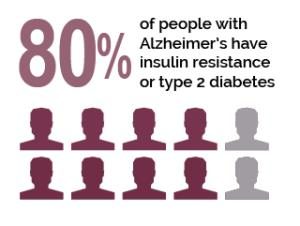
100 million American adults either have type II diabetes or prediabetes (if left unregulated will lead to type II diabetes in 5 years).
It is estimated that 5.7 million Americans are living with Alzheimer’s.
Both represent a significant physical and economic burden to both the impacted individual as well as the remainder of society. At first glance, it may seem like these two diseases are unrelated, however, recent studies have identified a link between the two.
How is type II diabetes characterized?
Type II diabetes is characterized by insulin resistance. Insulin is a hormone your body releases as a response to increased blood sugar levels (which are directly dependent on eating habits). After a meal, blood sugar levels rise, and the body sends insulin to tell cells to store sugar inside the cells rather than in the surrounding bloodstream. Initially, the body will release more insulin to accommodate the increased blood sugar levels, but overtime the body cannot make enough insulin to keep blood sugar levels normal.
How is Alzheimer’s characterized?
Alzheimer’s can only be diagnosed for certain by taking tissue samples and observing a build-up of neurofibrillary tangles and amyloid-beta plaques. A brain with Alzheimer’s also experiences significant brain atrophy, as seen in the image below.

These physical indicators are difficult to diagnose short of taking a tissue sample, therefore an Alzheimer’s diagnosis is determined almost exclusively on the presented symptoms of memory loss as well as mild cognitive impairment.
How are they connected?

- Inflammation
Insulin resistance as seen in type II diabetes is proposed to be a result of chronic inflammation in peripheral tissues of an increased amount of fat tissue. Although not caused by an excess of fat tissues, brains with Alzheimer’s have increased levels of inflammation as compared to a “normal brain.”
Additionally, amyloid-beta plaques in the hypothalamus (part of the brain that regulates hormones) have been shown to cause dysregulation of metabolism in peripheral tissues. Amyloid-beta plaques also mediate the further release of various inflammatory factors causing a cascade-like inflammatory response.
Evidence points to sustained inflammation being a mechanism of insulin resistance which is present in both type II diabetes and Alzheimer’s disease.
- Gangliosides
The brain has insulin receptors that are involved in pathways in the brain. Proper signaling is highly dependent on certain molecules being in the correct location. A cell can be portioned into different areas that accomplish different tasks- known as microdomains. An important factor of microdomains is cholesterol which acts akin to glue holding proteins together at the membrane, thereby making a more efficient signal, simply because the necessary molecules are close together. Gangliosides are commonly associated with microdomains and facilitate many reactions in the body; notably, the conversion from a single amyloid-beta molecule to a full blown plaque by having many aggregate together, a trademark of Alzheimer’s.
Diet has been shown to directly modify the type and frequency of gangliosides that become incorporated into a cell. Insulin receptors can be displaced from its proper location in a microdomain, essentially making it ineffective and modifying proper insulin signaling.
Important Takeaways:
- Type II diabetes and Alzheimer’s disease are related, and one increases the risk for the other
- Establishing a link between the two provides insight into two very prevalent diseases in the United States, which in turn could be helpful in finding particular therapies or treatments for one or both diseases
- Inflammation plays a critical role in the development of type II diabetes and Alzheimer’s alike
- Gangliosides have the potential to displace insulin receptors in the brain contributing to insulin resistance
- Taking measures to ensure you do not develop type II diabetes lowers your chances of developing Alzheimer’s at an older age
Sources:
https://www.nia.nih.gov/health/alzheimers-disease-fact-sheet
https://www.alz.org/alzheimers-dementia/facts-figures
https://www.cdc.gov/media/releases/2017/p0718-diabetes-report.html
